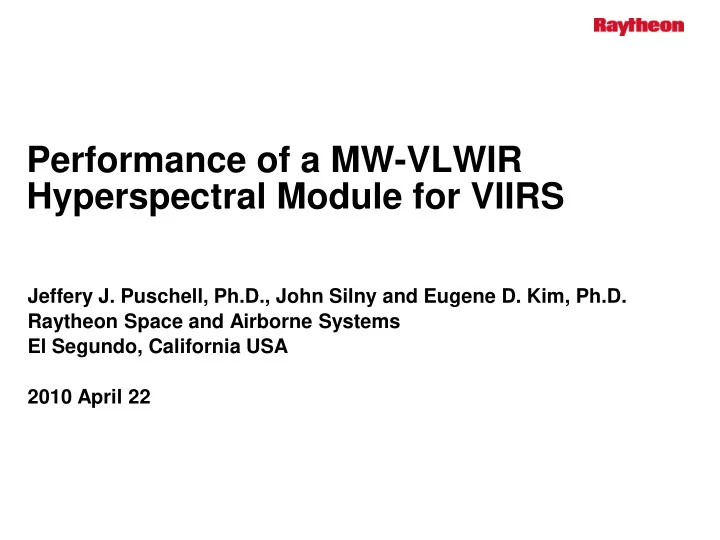

Performance of a MW-VLWIR Hyperspectral Module for VIIRS Jeffery J. Puschell, Ph.D., John Silny and Eugene D. Kim, Ph.D. Raytheon Space and Airborne Systems El Segundo, California USA 2010 April 22 Page 1
Test-proven VIIRS is expected to fly in 2011 Flexible VIIRS architecture can be adapted to meet a wide variety of needs, including hyperspectral infrared sounding
VIIRS converts visible/infrared scene photons into well-calibrated spectral radiance measurements VIIRS can be modified to replace the LWIR focal plane assembly and radiative cooler with a hyperspectral module and active cooler Sun Flexible VIIRS architecture allows for replacing and adding or removing spectral modules along with replacing radiative cooler with active cooler and updating calibration subsystems and electronics
VIIRS spatial sampling approach results in much better spatial resolution than AVHRR and MODIS, especially at end of scan 0.74km 0.74km 0.74km Fine-Resolution I DNB I DNB DNB I Imaging ‘I’ Bands 0.74km 0.74km 0.74km Day-Night Band ‘DNB’ 0.75km Moderate- 1.1km M 1.6km M M Resolution (“Radiometric”) 0.75km 1.2km 1.6km ‘M’ Bands Raw spatial samples for VIIRS hyperspectral module match I-bands
Two-grating hyperspectral module is compatible with well-understood VIIRS optical design Telescope Spectrometer Imager
VIIRS hyperspectral module can be optimized within a broad trade space defined primarily by spatial sampling, spectral range and spectral sampling interval Spatial sampling: VIIRS I-band spatial resolution with aggregation to M-band and larger pixel sizes to improve sensitivity • This study evaluates performance for I-band (~0.4 km at nadir), M-band (~0.8 km at nadir) and 1.5 km (defined here to be S-band) resolution Spectral range: contiguous coverage across 3.9 – 15.5 µm extends VIIRS spectral range to the center of the 15.5 µm CO 2 band and includes 6.7 µm H 2 O band • Two gratings cover full spectral range – design flexibility includes ability to overlap grating spectral ranges and to adjust range of each grating Spectral sampling: 10 nm spectral sampling interval provides spectral resolving power of 1550 at 15.5 µm (645 cm -1 ) and spectral resolving power of 390 at 3.9 µm • Spectral aggregation to VIIRS multispectral bands continues legacy I-band and M-band measurements with better sensitivity – MODIS bands could be synthesized, too
Hyperspectral module spectral range from 3.9 to 15.5 µm includes VIIRS and MODIS MW-VLWIR multispectral bands Hyperspectral coverage across this spectral range enables vertical temperature and water vapor soundings with ~1 km or better horizontal spatial resolution VIIRS M-bands VIIRS I-bands MODIS Hyperspectral Module spectral range
Advanced VIIRS could include a total of five spectrometers to cover and extend spectral range LW: 7.75 to 15.5 µm, 10 nm SSI HYPERSPECTRAL MODULE REVIEWED HERE MW: 3.90 to 7.80 µm, 10 nm SSI SW: 2.00 to 4.00 µm, 10 nm SSI NIR: 0.85 to 1.70 µm, 10 nm SSI VIS: 0.40 to 0.80 µm, 10 nm SSI
Radiometric sensitivity varies with spatial resolution and scene temperature – sensitivity limited by readout noise at short wavelengths 10 The values in the legend below refer to scene temperature and spatial sample 1 size at nadir Series1 NEdT (K) 250 K, 0.37 km Series2 250 K, 0.74 km Series3 250 K, 1.48 km 287 K, 0.37 km Series4 287 K, 0.74 km Series5 287 K, 1.48 km Series6 0.1 Spectral sampling interval is 10 nm (R = 1550 at 645 cm -1 ) LW detector operating temperature is 40 K Cold optics temperature is 60 K 0.01 0 500 1000 1500 2000 2500 3000 Wavenumber (cm -1 )
Key technologies bring Advanced VIIRS to practice Onboard processing is Spectrometer technology required to mitigate raw internal data rate of 881 Onboard processing Mpixels/sec • Spectral aggregation of raw hyperspectral Linear combinations of hyperspectral channels create legacy samples to multispectral multispectral bands resolution using VIIRS, 2.0 MODIS or other bands of 1 interest for I and M band 1.8 spatial resolution Normalized Response Composite Spectral Response 1.6 • Identifying and 1 Two grating reflective 1.4 automatically transmitting Response triplet grating cloud free (or some 0 1.2 spectrometers cooled practical number of) full 1.0 spectrum S-band spatial to a stable operating 0 samples temperature of 60 K 0.8 • Lossless and lossy data 0.6 -1 compression 0.4 Over time, system can be -1 improved to transmit 0.2 more high resolution 0.0 -2 data, as higher data rates 400 450 500 550 600 650 700 Wavelength (linear scale) Wavelength [nm] become available Flexible VIIRS design is compatible with Active cooling Detector arrays active cooling Proven multi-stage active coolers exist Focal plane is divided today that meet Hyperspectral VIIRS into MW and LW/VLWIR requirements sections Raytheon built the first actively cooled operational weather imager for MTSAT- Format size is 32x1160 1R with 169 x 508 µm 2 Flight proven active coolers offer many advantages over passive cooling detector elements – Improved radiometric sensitivity in longer – Physical array size is 1.6 wavelength bands, especially, over a long life, cm by 19.6 cm (total for because of ability to deliver lower detector operating temperature and capability to both sections) Raytheon space coolers reduce instrument background with cryogenic are flight proven – TRL 9 field stops Detector operating – Simplified ground testing of instrument by temperature is assumed eliminating need for laboratory coolers and to be 40 K cryogenic backgrounds for passive cooler – Reduced payload mechanical structure – Very robust against launch loads
Recommend
More recommend